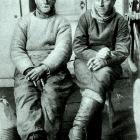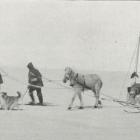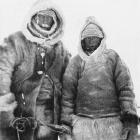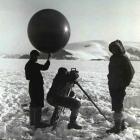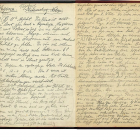NL001-008_081
Source: Alfred Wegener, Tagebücher, June 1912 – July 1913. DMA NL 001/008.

[081] Der Spaziergang zur Wasserfall-Schlucht war ziemlich beschwerlich gewesen: zuerst hatte mich Vigfus mit seinen großen Wasserstiefeln über den Elv tragen müssen, der auch hier oben so tief war, daß das Wasser in meine „langschäftigen“ Stiefel hineinlief. Dann mußten wir durch den weichen Lehmboden stapfen; der an manchen Stellen so ist, daß die Stiefel ganz versinken. Meist sinkt man aber nur etwa 10 cm ein, möglicherweise ist darunter Eis. Diese fast genau horizontale Lehmterrasse scheint den ganzen Eisrand zu begleiten. Für Pferde muß sie nicht gut zu passieren sein. Am Fuß der Eiswand, deren steiler Teil auf ca 20 m Höhe geschätzt wurde, (die Oberfläche des Inlandeises liegt wohl ca 30-40 m über dem Land) liegt ein Moränenwall, der nur an wenigen Stellen einen Talus unmittelbar am Eise bildet, vielmehr meist durch eine kleine
[081] The walk to the waterfall canyon was rather difficult: first, Vigfus, who was wearing big water boots, had to carry me across the elv, which is so deep up here that the water seeped into my tall boots. Then, we had to trudge through the squishy mud, which in some spots is so soft that our boots sank entirely into the ground. Most the time, you only sink in some 10 cm; maybe there is ice underneath. This almost perfectly horizontal “terrace” of mud seems to accompany the entire ice ridge. It won’t be easy for the horses to cross. At the foot of the ice ridge, whose steepest point was estimated at about 20 m (the surface of the ice sheet rests at about 30–40 m above the surface), lies a moraine wall that forms a talus. In some places, it is divided by a small




